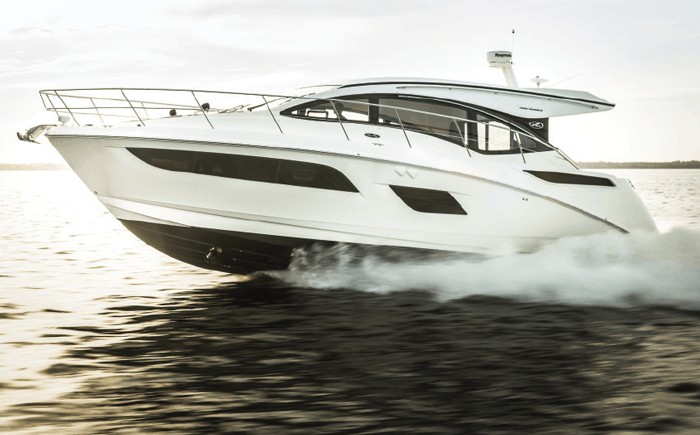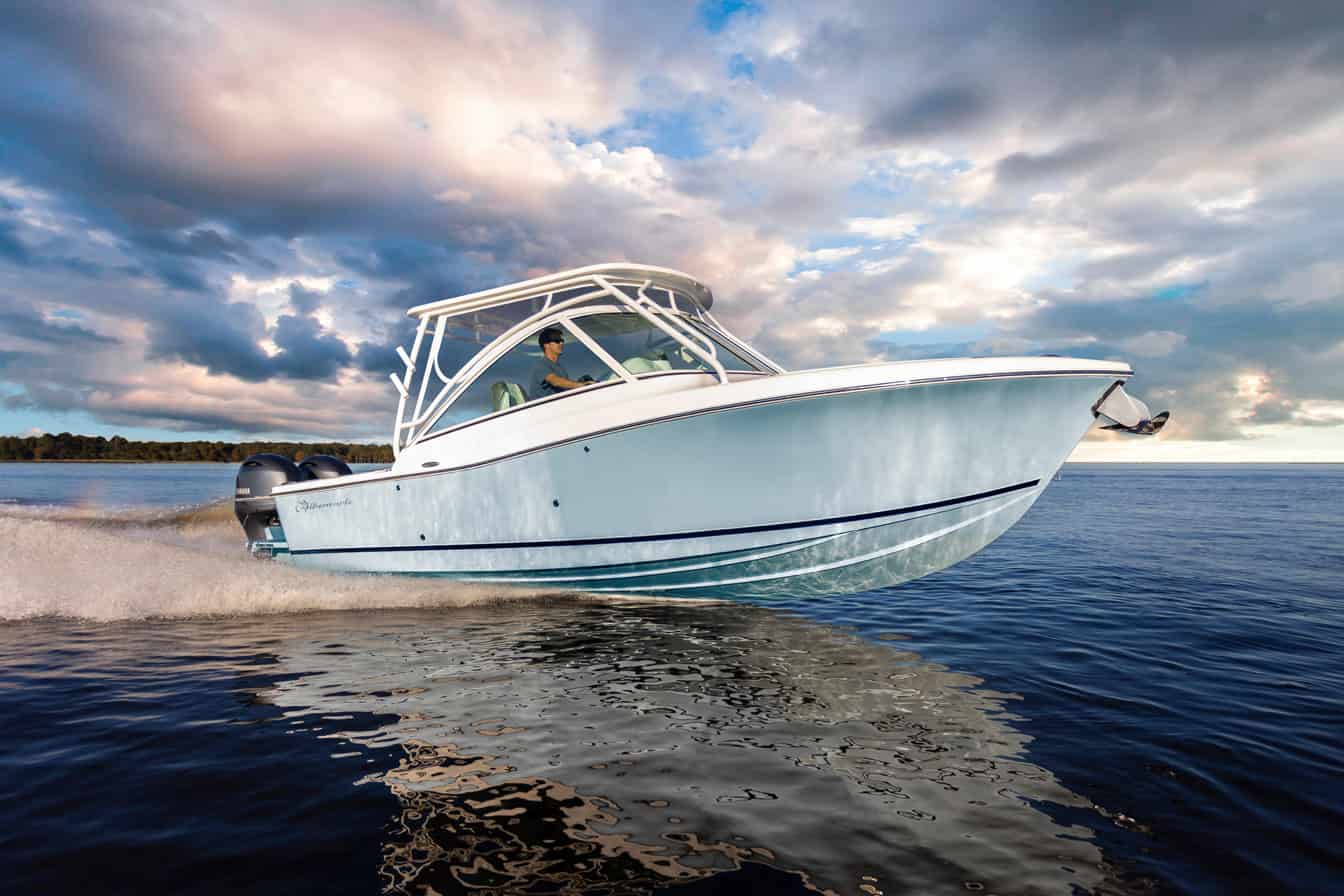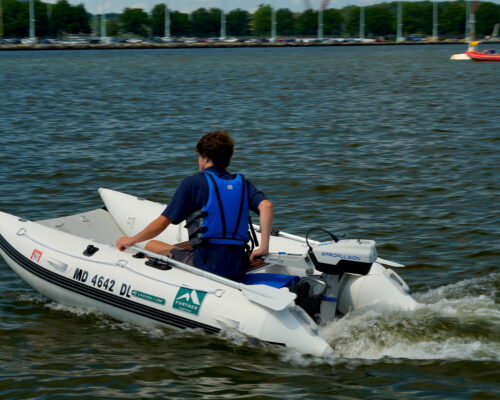“If there’s a way to include more functionality per foot, our engineers will find it.”
Cutwater C-24 CW
LOA: 29’2″
Beam: 8’6″
Hull Draft (Motors Up): 19″
Hull Draft (with Motors Down): 32″ Weight (dry, no engine): 6,300 lb.
Bridge Clearance: 8’2″
Max HP: 300
Fuel Capacity: 116 gal.
Fresh Water Capacity: 26 gal.
Waste Capacity: 13 gal.
For more information,
visit pocketyachtco.com or
cutwaterboats.com.
A full day on the water, and a rich, memorable, and safe experience—what does a boat have to give us to support that mission? Today, we ask for a lot: seaworthiness combined with shallow-water capability, speed with efficiency, comfortable sitting and standing, food/beverage storage and service, abundant gear storage (including space for bulky items like tow toys), shade on sunny days, a head sized for real people, fishing capabilities, and maybe a bunk for little ones to nap.
How large does a boat have to be for a manufacturer to pack all of that into one hull? Fluid Motion, the Pacific Northwest parent company of Ranger Tugs and Cutwater Boats, says 24’9″, citing its C-24 CW (Center Walkaround) and C-24 DC (Dual Console). The company has carved out a strong niche for compact cruisers with its two brands. “If there’s a way to include more functionality per foot, our engineers will find it,” proclaims the company’s website. That statement squares with our previous experience with Ranger Tugs. Now Cutwater is applying that expertise to these new day boats. Pocket Yacht Corporation, Fluid Motion’s longtime East Coast dealer, recently made a C-24 CW available to CBM’s On Boats for a sea trial off Annapolis. We came away impressed.
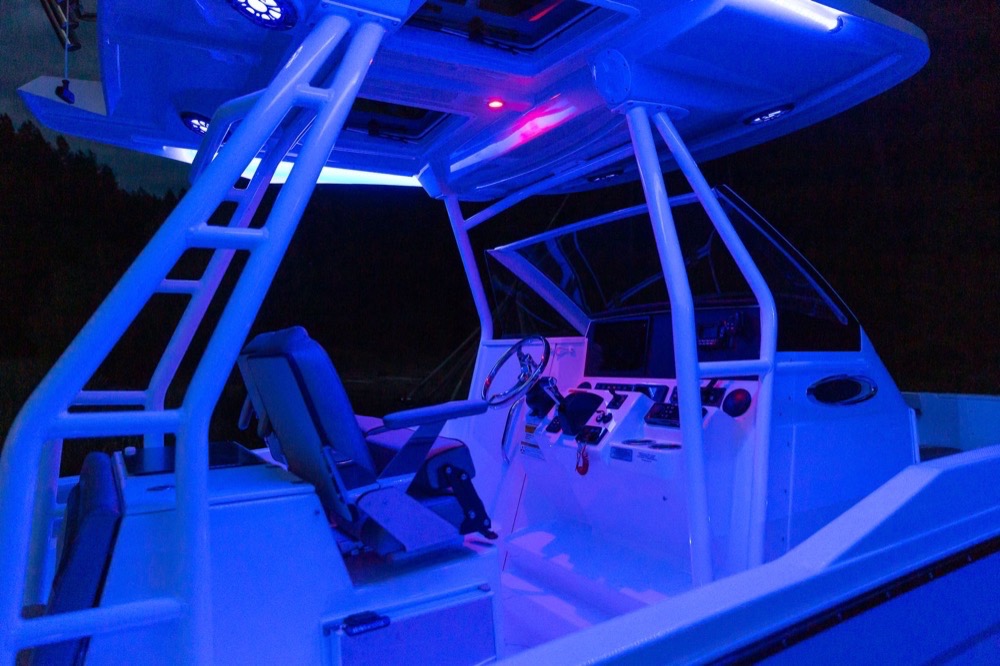
First, understand that 24’9″ applies to the boat but does not include the large, integrated swim platform/engine bracket. From the stemhead at the bow to the rear of the Yamaha outboard’s cowl, the length overall is 29’2″. Second, the C-24 hull has high sides, with a self-bailing cockpit built over a foam-filled stringer grid. It weighs a hefty 6,300 lb. dry, without engine. The interior layout is innovative: a control console offset slightly to port, with a wide walkway to starboard and a gunwale-level walkway to port (liberally supplied with handholds on the hardtop). The result is a bow compartment with upholstered lounges port and starboard, and a cushioned seat for two on the front of the console. The gunwales on the after end of the lounges hold twin cupholders and triple vertical rodholders. There’s a stanchion between the lounges for a removable table that can lower to form a sunpad. The flat bow deck has two hatches. To port is the locker for the anchor, chain, and rode, plus the windlass and a folding anchor roller. (True to its Pacific Northwest origin, the C-24 CW comes with an 11 lb. anchor, 15′ of high-tensile chain, and 150′ of rode). Under the starboard hatch lies a telescopic ladder for trips to sandbars. On the hook or the beach, this boat is happy.
The CW model’s hardtop forward support legs form the front corners of the console, with the rear legs anchoring the rear corners of the helm seat. The console offers a workmanlike helm with wheel, single lever throttle/shift control, compass, VHF, standard 9″ Garmin chartplotter/fishfinder (12″ unit optional), Yamaha engine data display, switches, stereo, controls for the trim tabs and bow thruster, and cupholders. Below the helm lies a two-level footrest.
Immediately to port is a companionway leading to the cabin. Enter and the wisdom of the raised gunwale to port becomes obvious. Headroom is 6’2″, with plenty of space for a counter and sink, plus horizontal storage racks for five fishing rods and a cushioned lounge. The porcelain head sits to starboard. The lounge extends forward under the bow compartment, though total length is only 60″—enough for a young person to nap. Beneath is considerable storage.
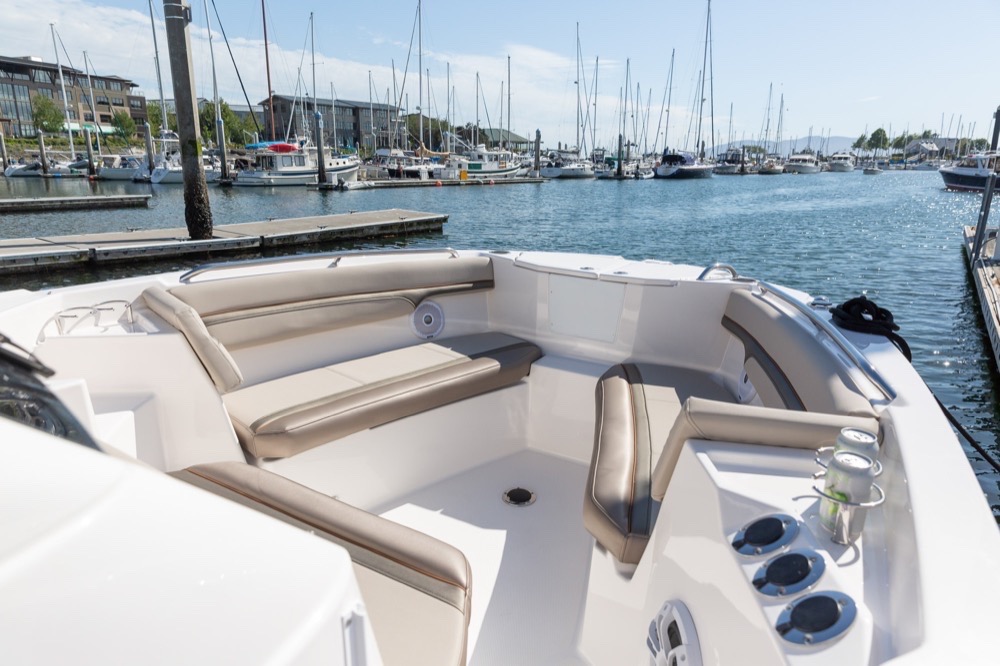
The helm seat is a large structure with multiple functions. There are adjustable seats for the skipper and a companion, with flip-up bolsters for standing and leaning. The sides below the seats provide a 12-volt refrigerator to starboard and a tackle storage compartment to port, while the aft side offers a cushioned seat for two on a slide-out cooler. Above the cooler is a cushioned seat back, and the flat surface above it holds an optional electric grill ($1,050 plus $1,700 for an optional inverter) and a sink with lid. The after edge of the hardtop above holds six vertical rodholders.
There’s more. Knowing the popularity of standup paddleboards and kayaks, those Fluid Motion engineers designed a sturdy rack for the hardtop that can hold two of either, without crowding out rods in the holders. Beneath the cockpit sole lie fish or storage boxes port and starboard, with a finished central compartment for access to wiring, plumbing, and tanks.
The transom’s face mounts a foldout seat for two. Above are a large livewell, a bait prep sink, another cooler, and a transom shower system with wand. Centered between the livewell and the sink is a pop-up ski tow stanchion. To starboard is a sturdy door to the swim platform/engine bracket. It holds a telescopic, stainless-steel boarding ladder and a grab rail. In terms of fishing, there’s not much in the Chesapeake that the C-24 CW can’t adapt to easily, except maybe working shallow underwater grass beds with fly rods. The cockpit sole is all on one level from the bow compartment aft all the way to the swim platform, which is broad enough to make working a big cobia or drum around the engine easy. There is plenty of rod and tackle storage, with flush-mount cleats and rodholders on the gunwales. The transom makes a good workstation for bait fishing. Pick the technique appropriate for the day and go.
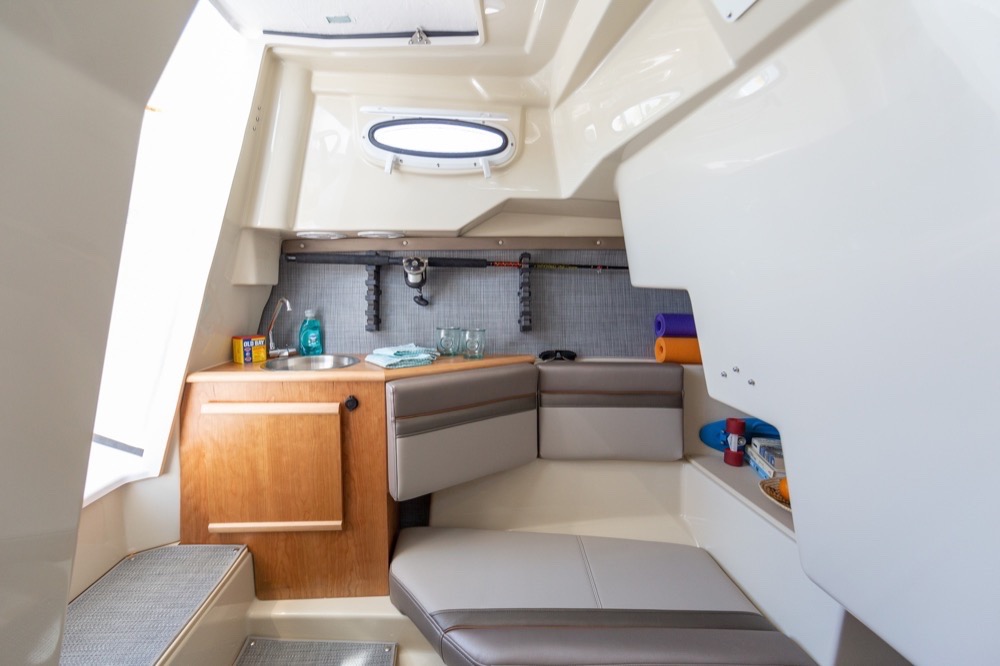
So how does this compact, do-everything day boat run? Its hull is interesting: variable deadrise deep-V with twin strakes and broad chines, laid up with precise, sharp edges to knock down spray. Roughly amidships on each side are twin steps to draw in air and reduce surface resistance. Proprietary Cutwater Laminar Flow Interrupters in the bottom between the strakes help to hold the hull firmly in turns. The wide chines give the hull easy motion at rest and drifting in all directions. Our test boat’s Yamaha F250 provided an ample top speed of 36 knots (5,900 rpm) with two aboard and three-quarters of a tank of fuel. More to the point, though, the boat was much happier—and more efficient—at 4,500 rpm (27 knots) than at 4,000 (15 knots), a sign of the speed at which the hull steps begin to prove their worth. Given the boat’s weight and intended uses with families and friends, I’d opt for the optional Yamaha F300 engine ($5,250). It’s in the same engine family as the F250, so there’s no increase in weight, and it provides a little extra shove to handle people, full coolers, and gear.
Cutwater’s “special factory direct pricing” for the C-24 CW starts at $125,937. For more information,
visit pocketyachtco.com or cutwaterboats.com.


